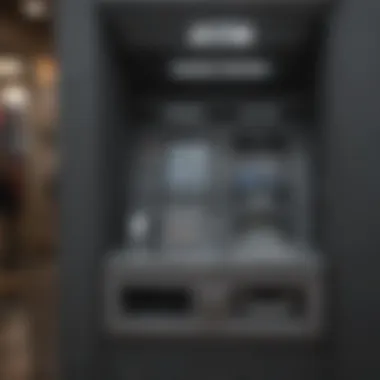Understanding ATM Withdrawal Limits: A Complete Guide


Overview of the Topic
Understanding ATM withdrawal limits is a vital piece of the personal finance puzzle that many overlook. An ATM withdrawal limit is simply a restriction set by banks and financial institutions on the amount of cash one can withdraw from an automated teller machine in a certain time period. This can vary from one bank to another and often reflects the institution’s policies about risk management and customer convenience.
Setting these limits serves several purposes. Firstly, they protect both the bank and the consumer from potential losses due to fraud or theft. Picture this: You’re traveling abroad, and your debit card is compromised. The bank has set withdrawal limits that can safeguard your funds by minimizing how much can be accessed at once. Secondly, withdrawal limits help control cash flow. For instance, if a bank knows its teller machines can only be accessed by a limited number of customers within a day, they can manage the amount of money kept on-hand.
In this guide, we’ll dive deeper into the many facets of withdrawal limits, including the distinctions between daily and weekly caps, as well as their implications on cash management for individuals.
Key benefits and implications
- Security: Protects consumers' funds from theft or fraud.
- Cash Management: Helps banks track and manage liquidity.
- Financial Planning: Encourages individuals to plan their withdrawals strategically, promoting better budgeting.
Exploring Strategies and Tips
Navigating ATM withdrawal limits can be a bit tricky if you don't know the ins and outs. Here are some practical tips on how to manage these limits effectively:
- Know Your Bank's Policies: Each institution has its own rules regarding withdrawal limits. Check your bank’s website or talk to a representative if unsure.
- Use Multiple Accounts: If you have accounts with different banks, utilize them to get around limits, if necessary. For example, a savvy consumer might withdraw from a credit union if their primary bank’s cap is too low.
- Plan Ahead: If you know you’ll need a larger sum of cash, like for a big event or holiday shopping, planning your withdrawals throughout the week can help you avoid hitting the limit unexpectedly.
By implementing these strategies, managing ATM withdrawals becomes less of a hassle and more of a proactive approach to personal finance.
Case Studies and Examples
To illustrate how ATM withdrawal limits operate in real-life scenarios:
- Traveling Abroad: A traveler figured out their bank's withdrawal limit was $300 per day. They meticulously planned their transactions, ensuring they had enough cash for their needs while protecting their funds from potential loss.
- Holiday Season: A family preparing for holiday shopping learned that their bank imposed a lower weekly limit. By alternating withdrawals between two accounts, they avoided the stress of short funds.
However, it’s essential to be wary of pitfalls. A case study showed a consumer who exceeded their limit without realizing it, leading to unexpected fees that put a dent in their budget—something to avoid at all costs!
Comparison of Financial Products
When discussing ATM withdrawal limits, it’s crucial to understand how different financial products stack up against one another:
Traditional Bank Accounts vs. Credit Unions
- Traditional Bank Accounts: Often have higher withdrawal limits but may charge fees for exceeding these limits.
- Credit Unions: Typically offer slightly lower limits, yet they may provide better customer service and lower fees overall.
Cash Management Accounts vs. Savings Accounts
- Cash Management Accounts: Enhanced flexibility in managing funds but come with variable limits.
- Savings Accounts: Generally enforce stricter withdrawal rules which might protect savings but can frustrate those needing cash on hand.
Understanding these differences enables consumers to choose the best financial product suited to their withdrawal needs and lifestyle.
Expert Insights and Recommendations
Industry experts often emphasize the importance of knowing your financial institution’s policies. They recommend:
- Stay Updated: Keep an ear out for any changes in withdrawal limits, particularly during the holidays or peak cash-use seasons.
- Link Accounts: Many banks offer the option to link accounts, which can sometimes ease cash flow challenges and provide quick access when limits are reached.
In sum, a thorough understanding of ATM withdrawal limits allows consumers to navigate their financial landscape more effectively, ensuring they are always in control of their cash—an essential aspect of personal finance management.
Defining ATM Withdrawal Limits
Understanding withdrawal limits is a crucial part of navigating any banking experience. ATM withdrawal limits essentially delineate the amount of cash you can extract from a bank machine at a given time, whether that is daily, weekly, or monthly. With this understanding, individuals can manage their cash flow more effectively, ensuring that their financial dealings remain smooth and predictable.
What Are ATM Withdrawal Limits?
ATM withdrawal limits refer to the maximum sums of money that an account holder can take out from an Automatic Teller Machine (ATM) during specified time frames. Most banks establish these limits to mitigate risks associated with fraud, ensuring a balance between accessibility to funds and safeguarding against unauthorized withdrawals.
For instance, a common daily limit might be around $300, meaning if you need to withdraw more cash, you would have to wait until the following day or explore other banking options such as a branch visit or digital transfers. This limitation can vary widely, influenced by the type of account you hold or policies adopted by your bank. Understanding these limits is fundamental for effective budgeting and planning to meet your financial needs.
History of Withdrawal Limits
Over the years, ATM withdrawal limits have evolved due to changes in banking practices, technological advancements, and regulatory measures.
- Early Days: Originally, ATMs were limited to small cash withdrawals, which reflected the overall security concerns of the time. As the technology became more widely adopted, banks gradually increased these limits.
- Post-2000 Era: As banks began to integrate advanced technology and better fraud detection systems, withdrawal limits started to be customized based on customer profiles and transaction histories. Some banks began to offer tiered limits for clients who maintained higher account balances, providing increased flexibility for those deemed low-risk.
- Recent Developments: With the rise of online banking and digital wallets, ATM limits are now part of a broader strategy for managing account security. Financial institutions often adjust these withdrawal ceilings in response to patterns in customer behavior and emerging threats in cybersecurity.
In essence, understanding the historical background of these limits gives context to why they exist today and how they can be modified in the future. As we look ahead, one thing is clear: the relationship between technology and banking continues to shape how we access our funds.
Purpose of ATM Withdrawal Limits


ATM withdrawal limits serve several essential functions that not only affect daily banking practices but also play a significant role in overall financial management. These limits exist to protect users, maintain the security of banking systems, and encourage responsible cash usage. Let’s dive into a few key elements that highlight the importance of these limits.
Security Concerns
When it comes to accessing cash from an ATM, security is paramount. Banks set withdrawal limits to mitigate risks associated with theft and fraud. Imagine someone losing their card or having it stolen – without limits, an individual could be left vulnerable to major losses in a very short time frame. By capping the amount that can be pulled from an ATM, financial institutions reduce the potential damage thieves can inflict.
Moreover, these safeguards help to build a layer of protection against unauthorized access. Users may not immediately notice if their account is tampered with, so having limits set can help in catching discrepancies sooner rather than later. It's like putting a guard dog outside your property; it may prevent an invasion even before it happens.
"Prevention is better than cure." This old adage rings true in this context, as ATM limits bring peace of mind to account holders, ensuring that their finances are not at risk of crippling losses in case of unexpected circumstances.
Fraud Prevention
Fraudulent activities in banking have seen unfortunate growth. As technoloy advances, so too do the tricks of the trade employed by fraudsters. Withdrawal limits act as a necessary countermeasure against such schemes.
If someone forges or hacks into your bank account, the financial damage they can inflict remains limited to what the daily withdrawal cap allows. Some banks tailor these limits based on transaction histories or behavioral patterns, making it harder for a scam artist to take advantage. Essentially, by setting specific ceilings on withdrawals, banks create a tighter net around their customers' funds, making it less appealing for criminals to target them.
Also, users who are aware of these limits can take a more cautious approach. Knowing there’s a ceiling encourages one to monitor their transactions regularly.
Manage Customer Cash Flow
ATM withdrawal limits can also be seen as strategic tools for banks to help manage a customer's cash flow. For a customer, it's like having a budget envy; while most of us desire to be able to spend freely, having guidelines ensures that we don't spend more than we can afford.
By controlling daily and weekly cash withdrawals, banks not only promote responsible spending but also encourage consumers to think twice about their withdrawal habits. Instead of making impulsive decisions that might lead to overdrafts or bad financial standings, limits force customers to plan and prioritize their cash needs. The reality is that maintaining a balance in withdrawal limits leads to healthier financial habits.
In summary, the purpose of ATM withdrawal limits is multifaceted—ranging from security enhancements and fraud prevention to promoting financial discipline among customers. While it may sometimes feel like an inconvenience, understanding the reasons behind these limits can transform them into valuable allies in managing personal finances.
Types of Withdrawal Limits
Understanding the different types of ATM withdrawal limits is crucial for anyone who regularly uses these machines. These limits directly affect the cash flow available to you, your financial planning, and can even influence your everyday spending habits. Knowing the specifics can save you from surprise fees or the frustration of not having enough cash when you need it.
Daily Withdrawal Limits
Daily withdrawal limits refer to the maximum amount of cash you can withdraw from an ATM within a 24-hour period. This is a common restriction, as banks want to mitigate risk associated with potential fraud.
Most often, daily limits range anywhere from a few hundred to a few thousand dollars. For instance, if your daily limit is set at $500, anything over that will either return an error message or require you to wait until the next day to withdraw more funds. This cap is particularly vital for budgeting, as it encourages individuals to think carefully about their spending habits. If you consistently find yourself hitting your daily limit, it might be worth assessing your cash needs and reaching out to your bank for consideration of an increase.
"Knowing your daily withdrawal limit can help you avoid the inconvenience of hitting the ATM more often than necessary."
Weekly and Monthly Caps
While daily limits take the spotlight, it's also important to consider weekly and monthly caps. These caps can vary significantly from institution to institution. For instance, while a bank might enforce a daily limit, it may also implement a weekly cap to further control how much cash you can access over a longer time span.
Typically, these caps could look like $3,500 weekly or $12,000 monthly. Some banks may roll engines on their caps. This means if you don't make a full withdrawal one day, you can bank that portion for future use. Others may not permit rollover. Understanding how these limits apply to your account can help you plan effectively, especially during financially stressful situations, like an emergency or planned travel.
Limit Variations by Bank
Withdrawal limits can fluctuate widely depending on the bank or financial institution you’re dealing with. Larger, established banks might maintain higher limits compared to credit unions or smaller banks, which sometimes promote tighter cash flow regulations to limit the risk of losses. For example, Chase Bank may allow you to withdraw up to $1,000 daily, while a local credit union might cap you at $300.
This variance makes it key for you to review your bank's policies before signing up. It's wise to inquire about their respective limits, especially if you're a frequent user of cash for your spending needs. Make sure to do your homework—checking customer reviews and even engaging in online discussions on platforms like Reddit can provide insights into what to expect from specific banks or credit unions.
Knowing your withdrawal limits and how they differ among financial institutions not only allows you to tailor your banking for your personal needs but also prevents you from running into unnecessary fees or restrictions when cash is most needed.
Factors Influencing ATM Withdrawal Limits
Understanding the factors that influence ATM withdrawal limits is crucial for anyone who regularly engages with their banks through automated teller machines. These limits are not set in stone and can vary widely based on several criteria. Knowing what affects these restrictions can empower customers to manage their finances more effectively and avoid potential inconveniences when making withdrawals.
Account Type
One of the primary influences on withdrawal limits is the type of bank account a person holds. Financial institutions offer a variety of accounts—checking, savings, and high-interest accounts, to name a few. Each of these comes with its own set of limits.
- Checking Accounts: Typically, these accounts have higher daily limits since they are meant for regular transactions. A standard checking account may allow you to withdraw anywhere from $300 to $1,500 daily.
- Savings Accounts: Here, withdrawal limits are generally lower, designed to encourage saving rather than spending. You might find these limits range from $100 to $500, depending on the bank.
- High-Interest Accounts: These accounts can sometimes come with tailored limits, often depending on the customer's balance. Higher balances can lead to increased limits.
The nature of accounts can also affect how easily one might access funds through an ATM. For instance, some banks offer special accounts targeted at students or seniors, and these often have more flexible limits.
Bank Policies
Bank policies play a significantrole in determining ATM withdrawal caps. Financial institutions set these rules based on their risk assessments and strategic goals. Here are some considerations:
- Risk Assessment: Banks analyze data regarding withdrawal patterns to mitigate risks like fraud. A bank aware that its customers make large withdrawals frequently might impose stricter limits to protect itself and its clientele.
- Competitive Positioning: Some banks might adopt a more attractive limit structure to draw new customers, which can lead to competitive advantages in their market.
- Technological Considerations: The technology used in ATMs can also dictate limits. Older machines may not be able to process large transactions efficiently, leading banks to implement lower withdrawal limits.
Each bank has its internal policies that can change over time, influenced by broader economic factors and customer needs.


Customer History
Lastly, an individual's transaction history with a bank significantly affects their withdrawal limits. Banks assess customer behavior to tailor services effectively. Factors influencing limits include:
- Account Longevity: Long-term customers might enjoy higher limits due to their established trustworthiness. A person has held an account for several years with consistent deposits could see their limits raised over time.
- Transaction Patterns: If a customer frequently withdraws maximum allowances without any issues, this behavior can prompt a bank to increase limits as a recognition of reliability.
- Credit Score: A good credit score can also play a role. Banks may view individuals with higher credit scores as lower risk, thereby granting them higher limits on withdrawals.
"A bank that knows its customers well can tailor services to meet individual needs, boosting satisfaction for everyone involved."
Increasing Your ATM Withdrawal Limit
When it comes to managing your finances, understanding ATM withdrawal limits is crucial, especially if you find yourself needing cash more often than your current limit allows. Sometimes, life throws unexpected expenses your way, or perhaps you just want to take out a larger sum than you’re accustomed to. This section dives into how you can increase your ATM withdrawal limit and the practicalities surrounding that process.
Requesting an Increase
The first step toward increasing your ATM withdrawal limit typically involves reaching out to your bank or financial institution. It’s not always as simple as pressing a button on an app; it often requires a little legwork. You may need to either call customer service, visit a local branch, or use the bank's online portal to make your request.
- Customer Service Call: Speak directly to a representative. Make sure to have your account details handy for verification.
- Online Request: Log into your banking app or website. Some banks offer direct options for limit increases in their settings.
- In-Person Visit: Sometimes, a face-to-face chat with your bank manager can go a long way, especially if you have a good history with the bank.
However, it’s wise to be prepared. They may ask questions about why you need the increase, so having a clear rationale can strengthen your case. For instance, if you plan to make a big purchase, or you’re traveling and need extra cash, explaining your situation can be beneficial.
Qualifying Criteria
Not every request for an increase will be approved, so it’s essential to understand the factors that banks consider. Here are some common criteria that could affect their decision:
- Account Type: Different account types come with different limits. Premium accounts generally allow higher withdrawals.
- Bank Policies: Each bank has its own rules about withdrawal limits, which can vary widely. Some might be more flexible than others.
- Customer History: If you have a solid standing with your bank, such as timely payments and minimal overdrafts, your chances of approval increase.
- Current Limit: If your current limit is significantly lower than the amount you're requesting, you may need to justify the increase more thoroughly.
Remember, increasing your ATM withdrawal limit can save you from running into pesky barriers when you need funds on short notice. Always check with your specific bank’s policies for clarity.
Always consider the potential risks and benefits of increasing your withdrawal limit. While it can provide you with greater access to your funds, it might also expose you to higher fees if you consistently exceed your spending cap. Keeping a close eye on your spending habits is a prudent practice after making this change.
Consequences of Exceeding Limits
Exceeding ATM withdrawal limits isn't just a minor inconvenience; it can lead to a cascade of consequences that affect both your finances and relationship with your bank. Understanding these ramifications is crucial for personal finance management. The penalties and impacts of surpassing these limits can vary from one institution to another, but keeping these factors in mind can save you a headache down the road.
Fees and Charges
One of the immediate consequences of exceeding your withdrawal limit is the imposition of fees. Many banks enforce a strict policy that penalizes customers who attempt to withdraw beyond their limit, resulting in a fee each time they try. This fee can range significantly, from a nominal $3 to as much as $35, depending on the bank and location. The constant fees can quickly add up, causing a dent in your budget. Often, customers aren’t aware of these penalties until they see an unexpected charge on their statement, which may lead to frustration. Furthermore, if you routinely go over your limits, your bank may consider changing your account to a less favorable type, with higher fees.
- Typical Charges for Exceeding Limits:
- $3 – $10 per exceeded transaction
- Additional fees for overdrawing your account
- Increased fees in higher tiers of service
Beyond direct charges, repeatedly exceeding your limit could lead to more indirect costs as well. For example, if your habitual withdrawals continually result in overdrafts, this could trigger additional bank charges that compound your losses.
Impact on Account Standing
Exceeding ATM withdrawal limits can also have a significant impact on your account standing with the bank. If a customer frequently requests transactions that breach their limits, banks may start to view this as a risk issue. This could result in the imposition of stricter limits on your account, leading to a rather vicious circle: needing more cash can result in being monitored more closely, which can further reduce access to cash.
Additionally, a poor track record of adhering to these limits could haunt you when applying for new accounts or services. Banks might view you as a less desirable customer, impacting your ability to secure loans or favorable rates. In more severe cases, this could lead to a negative impact on your credit score if your behavior is deemed irresponsible.
The constant tug-of-war between your immediate cash needs and regulatory restrictions can create tension, affecting not only your financial health but also your relationship with your financial institution.
In summary, it's clear that exceeding ATM withdrawal limits can trigger fees and may severely impact your account standing. By understanding these potential consequences, you can better navigate your banking experience and make smarter financial decisions.
ATM Withdrawal Alternatives
Exploring alternatives to ATM withdrawals is essential in today’s fast-paced financial environment. As consumers often face limits on their daily or weekly withdrawals, knowing how to navigate around these restrictions becomes paramount. This section uncovers various methods to access cash or transfer funds without relying solely on ATM transactions, providing insights into both the benefits and potential drawbacks of each option.
Bank Teller Withdrawals
When cash is needed beyond the ATM limits, going to a bank teller presents a straightforward alternative. Most people don’t realize how simple this can be. Walking into a branch not only allows for larger withdrawals but also offers personalized service. A bank teller can assist with transactions, address queries, and provide additional services like setting up new accounts or helping with investments.
However, here are a few practical considerations:
- Operating Hours: Unlike ATMs, bank branches have specific hours, which might not always align with your schedule.
- Identification: For larger amounts, carrying proper identification is a requirement.
- Location: Access may vary based on how many branches are nearby.
Using a bank teller ensures that you can withdraw a greater amount without the restrictions that an ATM imposes, making it a viable option for significant financial needs.
Digital Wallets and Transfers
The advent of technology has brought digital wallets into the forefront of personal finance. Services like PayPal, Apple Pay, or Google Wallet enable users to store funds electronically. Transactions can be done from smartphones, making the process swift and convenient. Additionally, many of these platforms allow users to easily transfer money to friends or family, making it an excellent choice for shared expenses.


Some benefits include:
- Convenience: No need to visit a physical location. Transactions occur on-the-go.
- Immediate Transfers: Many digital wallets offer instant transfer options, helping you get funds right away.
- Security: With increasing security protocols, digital wallets have become a safe choice for financial transactions.
While digital wallets bring ease, it’s important to consider:
- Fees: Some transactions may incur costs.
- Limitations: There are still daily limits for transfers, albeit often higher than ATMs.
Understanding these factors helps in deciding if a digital wallet aligns with your financial habits.
Peer-to-Peer Transfer Services
Peer-to-peer (P2P) transfer services, such as Venmo, Zelle, and Cash App, have fully integrated into the landscape of everyday finance. These platforms allow users to send money to one another without needing to withdraw cash physically. The ease with which you can transfer funds can be incredibly beneficial, especially for splitting bills or sending money in emergencies.
Features that make P2P services attractive include:
- Speed: Transfers are often instantaneous, meaning that you can send or receive funds quickly.
- User-Friendly Interface: Most users find these apps easy to navigate, even without a tech background.
- Social Integration: Commentary on transactions adds a social aspect that some people enjoy.
Nevertheless, being aware of potential issues is vital:
- Privacy: Sharing details can expose you to privacy risks.
- Transaction Limits: Many services have set limits on how much can be transferred in one go or within specific time frames.
In today’s digital age, understanding these alternatives to ATM withdrawals is crucial for effective personal finance management. By diversifying options, individuals can avoid unnecessary restrictions while ensuring they have access to their funds whenever needed.
Technological Impact on Withdrawal Limits
In the age where technology shapes every facet of our lives, ATM withdrawal limits are no exception. The evolution of technology in banking, especially with ATMs, has revolutionized how consumers manage their finances. Understanding this technological impact sheds light on the benefits and considerations for consumers navigating their withdrawal possibilities.
ATM Technology Advancements
With the rapid advancement of ATM technology, the capabilities of these machines have expanded beyond mere cash dispensing. Nowadays, ATMs are equipped with features that enhance both security and user experience.
- Biometric Verification: The integration of fingerprint and facial recognition is becoming more common. This not only ensures a higher level of security but also reduces the risk of fraud, enabling banks to maintain lower withdrawal limits while keeping customers safe.
- Enhanced User Interfaces: Touchscreen interfaces and multilingual options make it easier for users to navigate multiple functions. This improvement helps customers comprehend their limits and fees more clearly, ensuring they make informed decisions.
However, with these advancements, there's often a lag in the updating of banking policies that would reflect these technological changes. Customers may find themselves frustrated when the tech at the ATM seems to provide more options than what their bank allows.
Mobile Banking Influence
Mobile banking is another game changer that's shifted the landscape of ATM withdrawal limits. With the rise of smartphone apps designed by banks, customers now have more control at their fingertips. Through these apps, people can check their withdrawal limits in real time, transfer funds, and even temporarily increase their limits based on need.
- Real-Time Updates: Changes in withdrawal limits can now be communicated instantly via mobile apps, making it easier for users to adapt their spending habits without the need to visit a bank branch.
- Digital Security Features: The use of two-factor authentication enhances the safety of online banking activities. This promotes a sense of security, allowing customers to utilize their ATM withdrawal limits confidently.
"As technology continues to evolve, so too will our understanding and management of ATM withdrawal limits, creating better financial practices across the board."
Despite these advancements, it's important for consumers to remain vigilant. While technology can enhance convenience and security, it also opens the door to new vulnerabilities. Understanding the balance between leveraging tech for ease and maintaining personal control over finances is crucial for effectively navigating one's withdrawal limits.
The Future of ATM Withdrawal Limits
The landscape of ATM withdrawal limits is not static; it is continuously evolving in response to advancements in technology, shifting consumer behavior, and regulatory changes. Understanding what lies ahead in this domain is crucial for consumers and banks alike. As fintech innovations permeate the financial sector, the dynamics of ATM withdrawal limits may shift significantly. This evolution has the potential to enhance user experiences, improve security, and align with changing consumer preferences.
Potential Changes in Regulations
Regulations surrounding ATM withdrawal limits are often shaped by both consumer protections and financial institution needs. Recent discussions suggest that authorities may consider revisiting these regulations. Emerging trends in digital finance could require banks to adapt their withdrawal policies to be more flexible. For example, much of today's banking regulation is rooted in the traditional banking model, which could be outdated in our fast-paced, mobile-centric world.
In certain jurisdictions, regulators might push for higher transparency concerning withdrawal limits. Customers deserve to know not only the restrictions imposed by their banks but also the rationale behind these limits. Some banks may find themselves under pressure to lower their caps, particularly for loyal customers with a solid banking history. This is where the question of equity comes into play—ensuring that everyone has fair access to their funds, even amidst potential security concerns.
Additionally, as more consumers leverage digital wallets and other financial technologies, regulatory bodies might be compelled to develop guidelines that account for these innovations. As transactions become more instantaneous and less reliant on traditional ATM systems, we could witness a gradual shift in withdrawal policies that accommodate this new reality.
Customer Trends and Preferences
Today's consumers are more informed and demanding than ever. As such, their preferences regarding ATM withdrawal limits are shifting. Many individuals prefer personalized banking experiences that are tailored to their financial habits and needs. This means that banks may possibly offer flexible withdrawal limits based on customer profiles, providing a dynamic approach rather than static caps.
Moreover, with the increasing use of mobile banking apps, customers are now accustomed to managing their finances on-the-go. Insights garnered from transaction histories could enable banks to implement responsive withdrawal limits. For instance, if a customer consistently withdraws a certain amount over a few weeks, the bank might adjust their limit accordingly, offering convenience while ensuring security.
Additionally, as touchless and cardless transactions gain popularity, conventional ATMs may need to adapt to these changes. Consumers increasingly appreciate methods that reduce physical interaction with machines. This trend could set the stage for alternative mechanisms to adjust withdrawal limits, allowing users to not only view but also modify their constraints through mobile interfaces.
"As technology reshapes our financial landscape, adaptability will be key for banks. The ability to respond to customer needs may very well dictate a financial institution's success in the coming years."
In summary, the future of ATM withdrawal limits is poised for transformation, influenced by both regulatory changes and consumer preferences. As individuals navigate through their financial journeys, the evolution of limits will mirror their desires for convenience, security, and customization—an interplay that will be critical as we move further into the digital age.
The End
The importance of understanding ATM withdrawal limits can hardly be overstated, particularly in today's fast-paced financial landscape. As individuals navigate the complexities of personal finance, recognizing the implications of these limits is crucial for effective cash management. Withdrawal limits are not merely a restriction; they serve several practical purposes that benefit both the consumer and the institution involved.
Key Takeaways
- Adaptability: A clear comprehension of withdrawal limits allows individuals to plan their finances better and make informed decisions regarding cash availability. If you know your daily limit, for example, you can structure your withdrawals accordingly, avoiding inconvenience.
- Security Measures: These limits are fundamentally designed to enhance security. Limiting the amount you can withdraw at any given time minimizes the risk of losing large sums of cash due to theft or fraud.
- Communication with Banks: Engaging with your bank can offer insight into your particular situation. Understanding the rationale behind your specific withdrawal limits, and the criteria for any increases or decreases, can empower you in your financial dealings.



